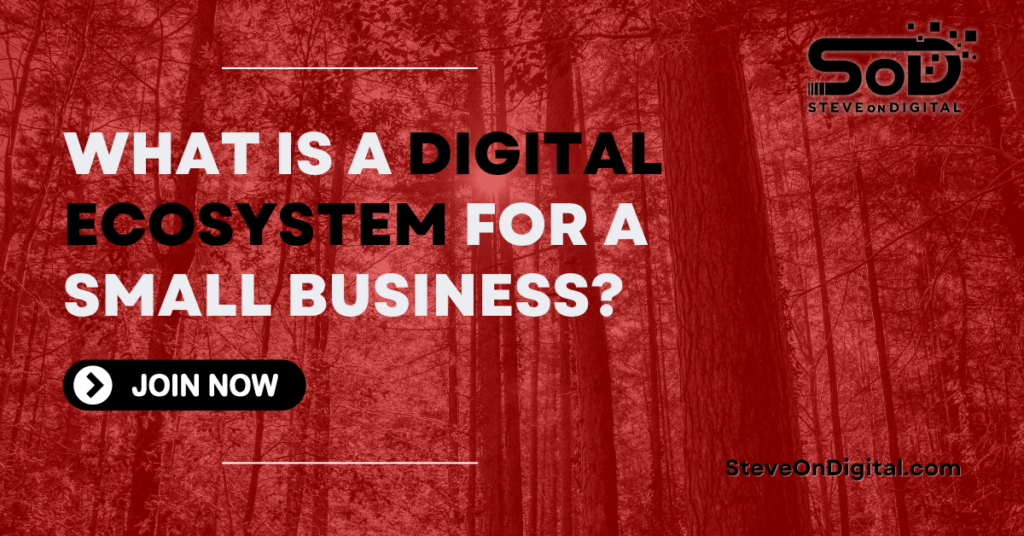A digital ecosystem for a small business is a network of interconnected digital technologies that enhances operations and customer interactions. It integrates various tech elements to streamline processes and improve engagement efficiently.
As a Digital Transformation Specialist, I, Steve Johnston, utilize my extensive background in electrical engineering, an MBA, and a master’s in Project Management to guide over a million business owners and IT directors through the digital landscape.
With my profound commitment to family and continuous learning, I leverage my presence on platforms like YouTube and LinkedIn to share valuable insights tailored for small and medium-sized enterprises.
My expertise is reflected in the practical advice and content I provide, aimed at addressing the unique digital challenges faced by SMEs today.
Unveiling The Digital Ecosystem Concept
As a digital transformation specialist, I’ve observed firsthand the transformative impact a well-structured digital ecosystem can have on a small business.
A digital ecosystem isn’t just a buzzword; it’s a comprehensive framework that enables businesses to thrive in an increasingly digital world.
A business ecosystem, as an integral part of this digital ecosystem, plays a pivotal role in enhancing operational efficiency and customer engagement through interoperability and innovation, ensuring seamless communication and collaboration.
Defining A Digital Ecosystem
A digital ecosystem, in its essence, refers to a network of interconnected digital technologies and platforms that businesses leverage to enhance operational efficiency and customer engagement.
This ecosystem integrates various elements of technology to create a cohesive environment where data and processes coexist seamlessly and effectively.
It’s about making technology work for you in the most integrated and efficient way possible. Moreover, the digital ecosystem model emphasizes that such scalability and customization are not exclusive to large enterprises.
Small and medium businesses can also benefit significantly from adopting digital ecosystem models, tailoring them to meet their unique needs and objectives, ensuring operational efficiency and enhanced customer engagement across all sizes of businesses.
Core Components
- Digital Platforms: The foundation of any digital ecosystem, these platforms facilitate all your digital activities, from sales and marketing to customer support.
- Business Partners: These are other companies you team up with to enhance your offerings or extend your market reach.
- Customer Interfaces: The touchpoints where your customers interact with your business, whether it’s through an app, website, or other digital mediums.
Impact Of Digital Ecosystems
- Enhanced Customer Experience: By integrating various digital touchpoints, businesses can offer a smoother, more personalized customer journey. This leads to higher satisfaction and loyalty.
- Streamlined Operations: Digital ecosystems allow for the automation of routine tasks and the optimization of business processes, resulting in significant time and cost savings.
Throughout my journey with SteveOnDigital, I’ve implemented numerous digital ecosystems for small and medium enterprises (SMEs).
One of the key lessons I’ve learned is the importance of choosing the right components that not only align with your business objectives but also enhance your capability to manage customer relationships and operations efficiently.
This strategy not only supports growth but also builds a resilient infrastructure capable of adapting to new challenges and opportunities in the digital age.
The Strategic Importance Of Digital Ecosystems
Understanding the value of digital ecosystems has been crucial in my journey with SteveOnDigital.
I’ve seen firsthand how these systems are indispensable for small businesses looking to gain a competitive edge and achieve sustainable growth.
The integration of digital technologies into your business operations isn’t just about keeping up with trends—it’s about setting the foundation for future success.
In exploring the dynamics of digital ecosystems, it’s essential to understand the various business models they encompass, such as functional digital ecosystems, platform ecosystems, and super platform ecosystems.
These models illustrate how businesses can leverage digital ecosystems to create and capture value, detailing revenue generation, the partners involved, and providing examples of companies successfully implementing these strategies.
Equally important is the evolution from traditional business models. As digital ecosystems redefine the relationships between clients, customers, and businesses, there’s a pressing need for businesses to rethink and reshape their approaches.
Moving beyond the sole aim of maximizing profits, adopting a new attitude towards collaboration within ecosystems is crucial for thriving in the digital age.
Advantages For Small Businesses
In my experience, the most immediate benefit of implementing a digital ecosystem is the dramatic improvement in operational efficiency.
By automating processes and minimizing manual tasks, businesses can focus more on strategic activities that drive growth.
For instance, using digital tools to manage inventory or streamline customer communications can save countless hours and reduce errors, which directly translates into cost savings.
Another significant advantage is the expanded market reach.
Digital ecosystems enable small businesses to operate on a global scale without the need for physical expansion.
With the right digital platform, even a small local shop can reach customers worldwide, providing opportunities that were once exclusive to larger corporations.
Customer loyalty is also enhanced through digital ecosystems.
| Benefit | Description |
| Enhanced Customer Experience | Integrates various touchpoints for a smoother, personalized customer journey. |
| Operational Efficiency | Automates routine tasks, freeing up time for strategic activities. |
| Access to New Markets | Enables global reach without the need for physical expansion, using digital platforms. |
| Cost Efficiency | Reduces operational costs by streamlining processes and reducing manual labor. |
By creating more touchpoints and facilitating easier interactions, businesses can build stronger relationships with their customers.
Personalized marketing, powered by customer analytics, allows businesses to offer tailored solutions that meet individual needs and preferences, fostering a sense of loyalty and increasing customer retention.
The Role Of Data Analytics
Data analytics, bolstered by digital technology, is the cornerstone of any successful digital ecosystem.
In my role, leveraging data analytics and digital technology has not just been about collecting data but transforming it into actionable insights that drive decision-making and innovation.
For example, understanding customer behavior patterns through digital technology helps tailor marketing strategies that resonate more effectively with target audiences.
Effective use of data analytics, enhanced by digital technology, also involves optimizing operations for efficiency.
Through real-time data monitoring enabled by digital technology, businesses can identify bottlenecks in their operations and adjust processes accordingly.
This dynamic approach, powered by digital technology, ensures that the business remains agile and can respond quickly to changing customer behaviors, market trends, and internal challenges, thereby improving their ecosystem strategies.
Building Your Digital Ecosystem
Developing a functional digital ecosystem is like constructing a house; it requires careful planning, the right tools, and a clear understanding of the end goal.

As I’ve worked with various small businesses through SteveOnDigital, the success of digital transformation projects often hinged on meticulous alignment with business objectives and the strategic selection of technologies.
Here’s a breakdown of how to build your digital ecosystem effectively.
Aligning With Business Objectives
One of the first steps I take when advising businesses is to align digital strategies with their broader business goals.
This alignment ensures that every piece of technology and every process not only fits with the current operational needs but also propels the business towards its long-term objectives.
For example, if a business aims to enhance customer experience, we focus on implementing digital interfaces and customer analytics tools that provide deeper insights into customer behaviors and preferences.
Aligning with business goals isn’t just about technology; it’s about ensuring that every digital initiative supports overarching strategic aims such as increasing market reach, improving product offerings, or optimizing customer service.
Choosing The Right Technologies
Choosing the right technologies is critical in building a digital ecosystem that is not only robust but also scalable and flexible.
The technology needs to grow with the business and adapt to changing market conditions without requiring complete overhauls.
The right choice of technologies is a cornerstone in building successful digital ecosystems, especially for small businesses aiming for growth and innovation, by enabling them to cut costs, be more agile, create products faster, collaborate internally, connect with other companies, share resources and expertise, achieve digital innovation and transformation, and meet various user needs.
Key Technologies
- Cloud Computing: Cloud solutions offer scalability and flexibility, allowing businesses to manage data and operations without heavy upfront investments in physical infrastructure.
- Advanced Analytics: These tools provide the capability to analyze large sets of data for better decision-making. By understanding customer trends and operational performance, businesses can make informed strategic decisions.
Steps To Implementation
- Initial Setup and Integration: The first step involves setting up the core technologies that will form the foundation of the digital ecosystem. This often includes integrating new software with existing systems, a process that must be handled with precision to avoid disrupting business operations.
- Ongoing Evaluation and Adjustment: Digital ecosystems are not set-and-forget solutions. They require continuous monitoring and refinement. Regularly evaluating the performance of your ecosystem ensures it remains aligned with business goals and performs optimally. Tools like dashboards and real-time alerts can help monitor the health of your digital ecosystem and identify areas for improvement.
Throughout my career, I’ve seen small businesses transform their operations through effective digital ecosystems.
From a local bakery using e-commerce to reach new customers to a service provider leveraging data analytics to improve client interactions, the possibilities are endless.
The key is to start with a clear strategy, choose the right technologies, and remain flexible to adapt as your business and the digital landscape evolve.
| Step | Action Item |
| Initial Setup | Choose and integrate foundational digital technologies like CRM systems, e-commerce platforms, etc. |
| Integration with Existing Systems | Ensure new technologies work seamlessly with existing business processes and systems. |
| Ongoing Evaluation | Regularly assess the effectiveness of technologies and make adjustments as needed. |
By following these guidelines, you can ensure that your digital ecosystem not only meets your current needs but also positions your business for future success.
Integrating Super Platforms
In the digital landscape, super platforms, particularly those within the super platform ecosystem, have become game changers for businesses of all sizes, but especially for small businesses looking to expand their capabilities without the overhead of large investments.
A super platform ecosystem represents the most complex type of digital ecosystem, integrating a wide range of services and functionalities into a single, cohesive solution.
These ecosystems not only simplify the technology stack but also enhance operational efficiency by capturing user data and leveraging it for business growth.
Major tech giants like Apple, Google, Amazon, and Tencent control the majority of these super platform ecosystems, with at least 10 million partners involved across global industries, showcasing how super platform ecosystems integrate various services into one integrated service.
Benefits Of Super Platforms
Super platforms offer a centralized function system that can drastically enhance the efficiency of digital operations.
For instance, platforms like Salesforce or Microsoft 365 integrate customer relationship management, data analytics, and content creation tools in one suite.
This integration means I can manage my operations at SteveOnDigital more seamlessly, from customer interactions to marketing campaigns, all under one roof.
The ability to expand capabilities is another significant benefit.
These platforms often come with a range of built-in tools and the flexibility to add more as needed.
For small businesses, this means you can start with what you need and expand as you grow, without having to switch platforms or invest heavily in new technologies.
Examples Of Integration
Many small businesses I’ve worked with have leveraged super platforms to great effect.
For example, a local boutique that started using Shopify not only streamlined its e-commerce operations but also tapped into Shopify’s marketing and SEO tools to increase its online visibility.
Another client integrated Slack into their operations to enhance internal communication and project management, which significantly improved their team collaboration and project turnaround times.
Optimizing Customer Interactions
Optimizing how customers interact with your business is crucial for building lasting relationships and driving sales.

Digital ecosystems play a vital role in this optimization by providing the tools and data needed to understand and enhance every step of the customer journey.
Customer Journey Mapping
Customer journey mapping involves analyzing every touchpoint a customer has with your business, from initial contact through to post-purchase interactions.
By understanding these touchpoints, I’ve been able to help businesses identify areas where they can improve interaction, such as simplifying the checkout process on an e-commerce site or enhancing the information available on a product page.
Personalization Through Analytics
Using customer data to personalize experiences is a powerful way to build loyalty and satisfaction.
Data analytics tools can help decipher patterns and preferences in customer behavior, allowing businesses to tailor their offerings and communications effectively.
For instance, by analyzing purchase history and browsing data, a business can offer personalized discounts or product recommendations, making the customer feel recognized and valued.
Incorporating these strategies within a digital ecosystem not only enhances customer experience but also drives efficiency and growth by ensuring that every interaction is optimized for engagement and conversion.
As small business owners, adopting these approaches means we can compete more effectively in our markets, offering customer experiences that rival even our largest competitors.
Partnerships And Collaboration
In my journey of supporting small businesses through digital transformations at SteveOnDigital, I’ve learned that one of the most effective ways to amplify your digital ecosystem’s capabilities is through strategic partnerships and collaborations.
These alliances can extend your technological reach and bring new insights and innovations to your business that were previously out of reach.
Forming The Right Partnerships
Selecting the right partners is crucial.
The criteria I recommend involves looking for companies that complement your existing capabilities and share your vision for growth and innovation.
It’s not just about what you can gain from them but also what you can offer, creating a mutually beneficial relationship.
For example, a partnership with a tech company might provide you with advanced analytics tools, while you offer them insight into the small business market—a win-win scenario.
Here are a few points I focus on when forming partnerships:
- Alignment of Values and Goals: Partners should have similar values and a shared vision to ensure smooth collaboration.
- Complementary Strengths: Each partner should bring unique strengths that enhance the overall capabilities of the ecosystem.
- Scalability: Partnerships should be able to grow and evolve as your business expands.
Success Stories
I’ve witnessed several success stories where partnerships significantly enhanced a business’s digital ecosystem.
For instance, a local retail store I worked with partnered with an e-commerce platform to broaden its online presence.
This partnership not only increased its sales but also improved its inventory management through integrated digital tools provided by the platform.
Another client joined forces with a cybersecurity firm, which helped them enhance their data security measures, a crucial aspect of maintaining customer trust.
Navigating Challenges And Risks
While the benefits of digital ecosystems are substantial, they come with their set of challenges and risks.
Being proactive in addressing these potential issues is key to ensuring the longevity and effectiveness of your digital infrastructure.
Data Security Concerns
Data security is a paramount concern in any digital ecosystem.
Implementing robust security measures to protect sensitive customer and business data is non-negotiable.
I always advise using encryption, secure access protocols, and regular security audits to safeguard your systems.
It’s also essential to educate your team on security best practices, as human error is often the weakest link in data security.
Regulatory Compliance
Complying with legal standards and regulations is another critical aspect, especially given the varying requirements across different regions and industries.
For small businesses, this can seem daunting, but compliance is crucial for avoiding legal issues and building trust with your customers.
Whether it’s GDPR, HIPAA, or other regulatory bodies, understanding and adhering to these regulations is a must.
Employing legal experts or specialized compliance software can help manage these requirements more efficiently.
Measuring Ecosystem Success
In the world of digital ecosystems, knowing how to measure success is critical.
As someone who has guided numerous small businesses through digital transformations, I’ve learned that without proper metrics, it’s difficult to gauge the health and effectiveness of your digital strategies.
Key Performance Indicators (KPIs)
Identifying and tracking the right KPIs is essential for any business looking to truly understand the impact of its digital ecosystem.
These indicators should be closely tied to your core business objectives and can include metrics like website traffic, user engagement, conversion rates, and customer retention rates.
For example, if one of your goals is to improve customer service, metrics might include response times and satisfaction scores.
Here are a few KPIs I consistently monitor:
- Customer Acquisition Cost (CAC): Measures the cost associated with acquiring a new customer.
- Lifetime Value (LTV): Indicates the total revenue a business can reasonably expect from a single customer account.
- Operational Efficiency: Looks at the reduction in time and cost to perform necessary business operations.
| KPI | Purpose |
| Customer Acquisition Cost (CAC) | Measures the cost involved in acquiring a new customer to evaluate marketing efficiency. |
| Customer Lifetime Value (LTV) | Estimates the total revenue a business can expect from a single customer throughout their relationship. |
| Operational Efficiency | Tracks improvements in time and cost for business operations after digital interventions. |
Continuous Improvement
The digital world is always evolving, and so should your digital ecosystem.
Continuous improvement involves regular reviews and adjustments based on your KPIs’ data.
This could mean tweaking your marketing campaigns, adopting new technologies, or even reevaluating customer touchpoints to ensure they’re as effective as possible.
In my practice, I set quarterly reviews for all digital initiatives to ensure they align with current business goals and market conditions.
Future Trends In Digital Ecosystems
As we look forward, it’s clear that the landscape of digital ecosystems will continue to evolve, bringing new challenges and opportunities for small businesses.
Emerging Technologies
Staying ahead in the digital game means keeping an eye on emerging technologies.
For instance, artificial intelligence (AI) and machine learning are revolutionizing how businesses interact with customers through personalized experiences and predictive analytics.

Blockchain technology is also emerging as a key player in enhancing security and transparency in business operations.
As these technologies become more accessible, they will play a pivotal role in shaping the future of digital ecosystems.
Adapting To Market Changes
The ability to adapt quickly to market changes is more crucial than ever.
Small businesses must remain agile, ready to pivot strategies as consumer behaviors and technological advancements shift.
This might mean adopting more flexible cloud solutions, integrating more responsive data analytics tools, or even shifting your business model to accommodate new market realities.
For instance, during the COVID-19 pandemic, I helped a retail client shift from a brick-and-mortar only model to an integrated e-commerce solution within weeks.
This shift was crucial in maintaining their operations and even allowed them to reach a broader customer base than before.
Final Thoughts
As we wrap up our comprehensive exploration of what a digital ecosystem can do for a small business, it’s clear that the integration of digital technologies into your business strategy isn’t just beneficial—it’s essential for survival and growth in today’s market.
I’ve walked through this journey with many clients at SteveOnDigital, seeing firsthand the transformative power of digital ecosystems.
The Strategic Imperative
The digital age demands agility and foresight, and the proactive adoption of digital ecosystems is no longer optional.
It’s a strategic imperative.
Small businesses must embrace digital transformation to remain competitive and relevant.
This means not only adopting new technologies but integrating them in a way that transforms operations, enhances customer experiences, and drives business growth.
Every digital interaction and process should be a step towards achieving your broader business objectives.
From my experience, those who have embraced these transformations have not just survived; they have thrived, discovering new markets and opportunities for innovation that were previously unimaginable.
Getting Started
Starting your journey toward building a robust digital ecosystem can seem daunting, but with the right approach and resources, it’s entirely achievable.
Here are some practical steps to get you started:
- Assess Your Current Technology: Understand what digital tools you are currently using and identify gaps where additional technologies could help streamline operations or enhance customer interactions.
- Define Your Business Goals: Clearly define what you want to achieve with your digital transformation. This could be anything from improving customer service to increasing operational efficiency or expanding to new markets.
- Develop a Phased Approach: You don’t need to overhaul your entire business model overnight. Start small, perhaps by automating a single process, and scale up as you gain confidence and see results.
- Consult with Experts: Engaging with digital transformation experts like us at SteveOnDigital can provide you with insights and guidance tailored to your specific needs.
- Train Your Team: Ensure that your team understands and is capable of using new technologies. Training and development are crucial for a smooth transition.
- Monitor and Adjust: Once your digital tools are in place, continuously monitor their performance and make adjustments as needed. This iterative process is key to long-term success.
| Phase | Description |
| Assessment | Evaluate current processes and technology. Identify gaps and areas for improvement. |
| Planning | Set specific, measurable goals for digital transformation tailored to enhance business operations. |
| Implementation | Start with critical areas that offer the most benefit and gradually expand to other sectors. |
| Monitoring & Adjusting | Use KPIs to monitor performance and make necessary adjustments to stay aligned with business goals. |
Embracing a digital ecosystem is about more than just technology; it’s about setting up your business for future success.
The digital landscape continues to evolve, and staying ahead means being adaptable, strategic, and informed.
If you’re ready to start this journey, remember, the path doesn’t have to be traveled alone.
Experts in digital transformation are ready to guide you through each step, ensuring that your move towards a digital ecosystem is both successful and sustainable.

